The Philippines is a well-known tropical destination; after all, a lot of foreign travelers seek its crystal-clear beaches, picturesque landscapes and warm hospitality that is like no other! However, apart from this, it helps to know that the archipelago is also known for its unique and delicious food. (Philippines Food)
To start off, Philippines food or Filipino cuisine is a culmination of more than a hundred distinct local groups and tribes all throughout the country. From its Austronesian origins, it has since evolved to a mixed cuisine of American, Chinese, Indian, and Spanish influences that range from simple to complex dishes. One would even say that it is the ultimate fusion food that not only represents the different cultures all over the country but also of how “east meets west”.
With a rich culinary heritage and a wide range of food choices to pick from, it’s pretty hard to narrow down this list to 10 Philippines food only — but I can share with you here the top dishes that everyone should NOT miss when visiting the country!
Best Philippines tours?
Come and check out this list of the top things to do in the Philippines which features the best activities and tours to do in Manila, Cebu and more!
.
.
#1 – Adobo
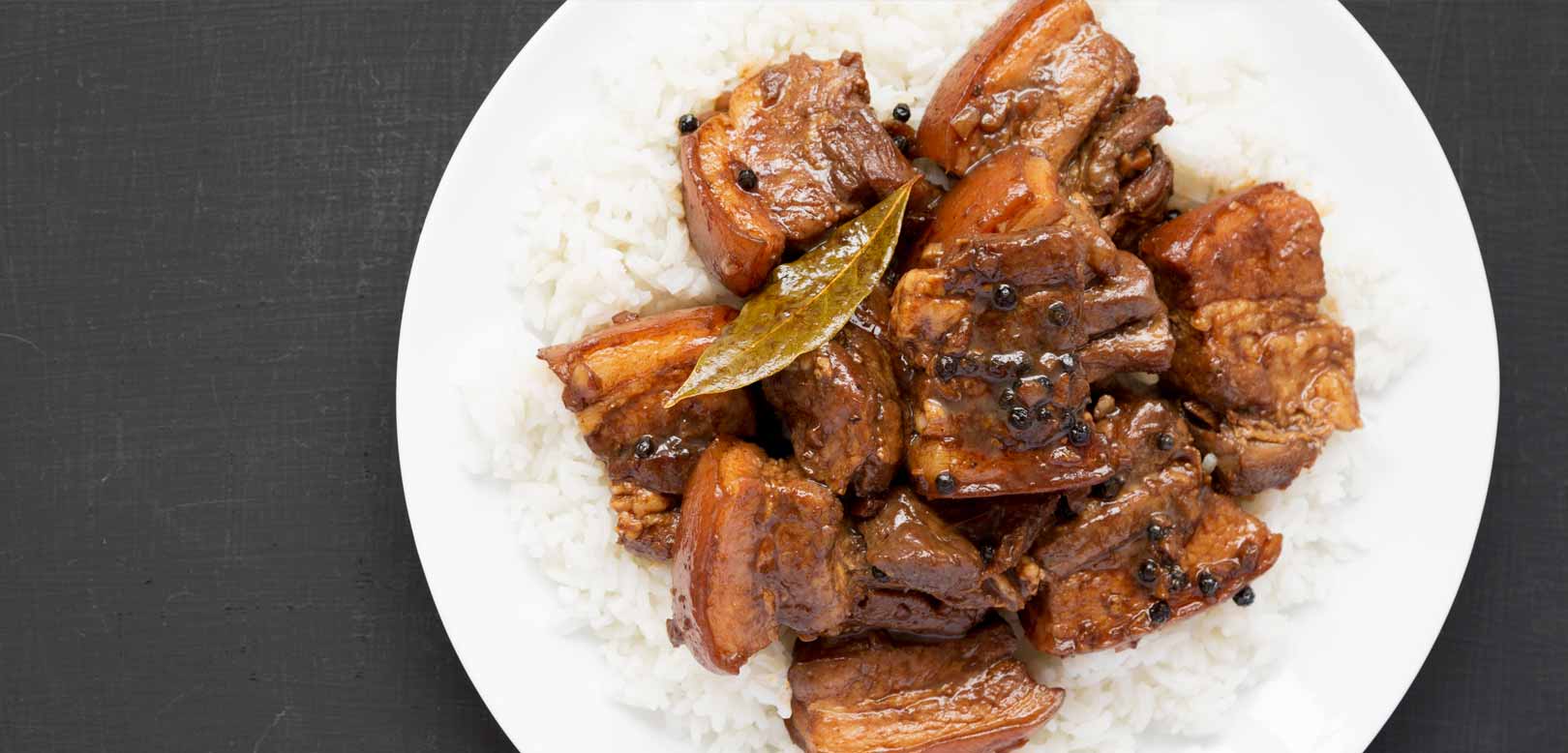
Adobo can be considered as the most popular dish out of all the Philippines food, and it is definitely loved by everyone — westerners’ palate included. In fact, it can even be considered as the ‘national dish’ of the country!
The most common type of adobo uses chicken or pork meat and it is first marinated in garlic, black peppercorns, bay leaves, soy sauce, and vinegar. After some time, it will be browned in oil and then simmered to goodness in its marinade. Pair it off with some good ol’ rice and you’re bound to have it as your new favorite viand!
Where to best eat it? Most Filipinos know how to cook adobo, so if you happen to befriend a local, they’ll be more than happy to cook it for you! Most households even have different styles or recipes for cooking the said dish. Either way, for new foreign travelers, you can easily ask around for the nearest restaurant (e.g. Sentro 1771, Abe, Adobo Connection, etc.) that can whip up this Filipino dish for you!
.
#2 – Lechon
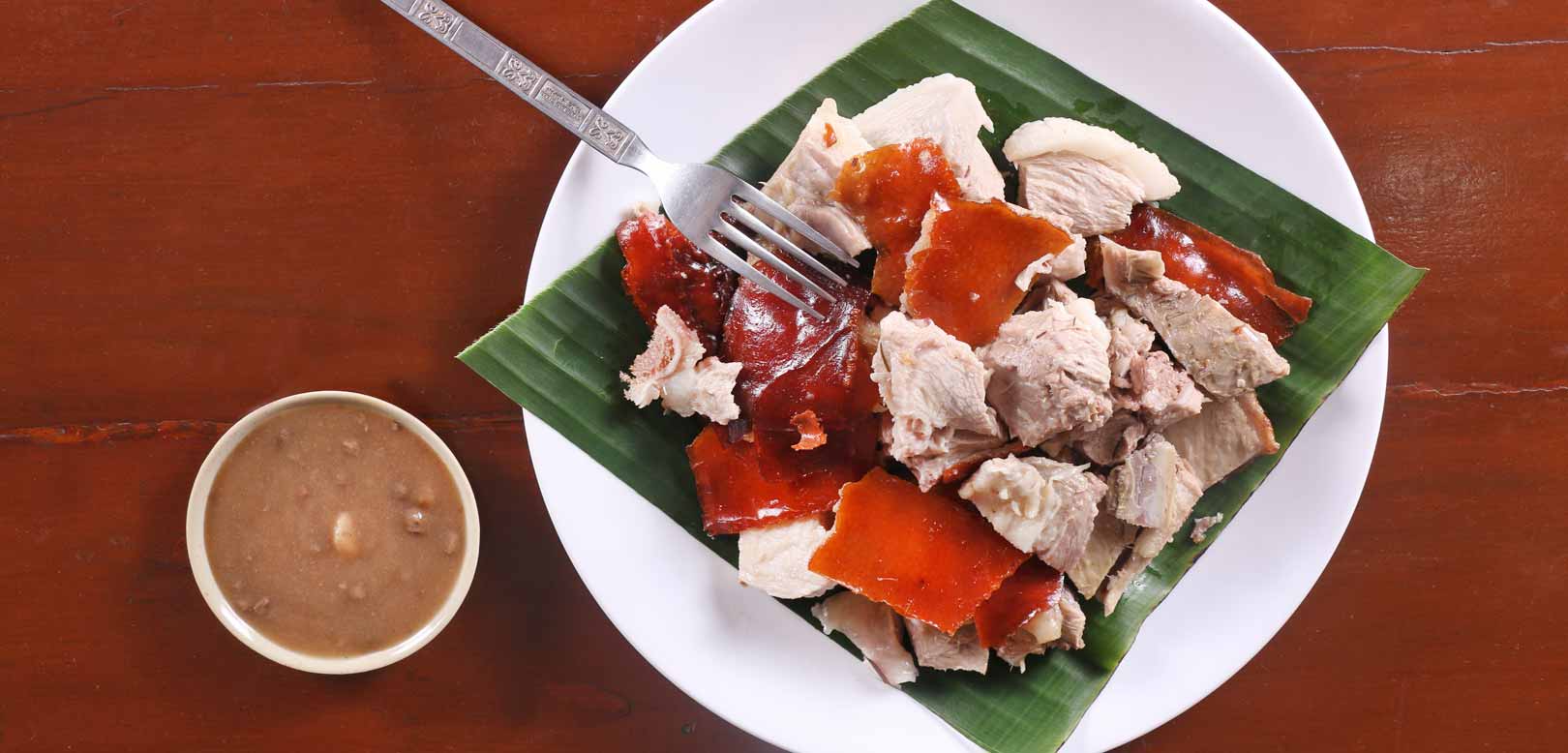
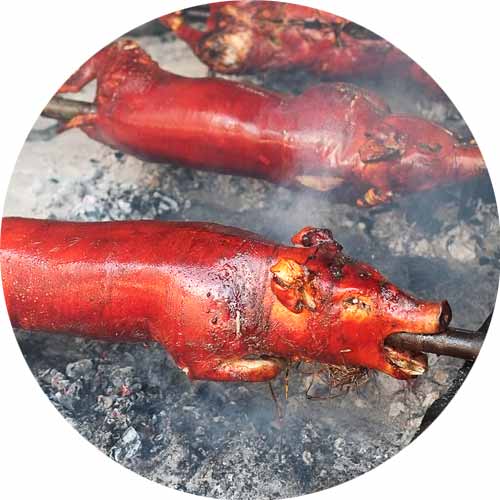 Lechon or ‘roasted suckling pig’ is also a popular Philippines food and it is commonly served during fiestas or special occasions like birthdays, weddings, etc.
Lechon or ‘roasted suckling pig’ is also a popular Philippines food and it is commonly served during fiestas or special occasions like birthdays, weddings, etc.
Lechon is also one of the many Spanish influences to Filipino cuisine with 2 typical variants being ‘Manila or Luzon lechon’ and ‘Visayas or Cebu lechon’. The former is typically only seasoned with salt and pepper before roasting; but the latter is usually stuffed with many spices such as lemongrass, tamarind, garlic, onions, and chives among many others as it is slowly roasted in an open fire for several hours. It will be continually basted and turned until the skin becomes crispy — a distinctive feature of the dish that Filipinos love. Once ready, whip up a plate full of rice and grab some lechon sauce like the local favorite of ‘Mang Tomas‘ and you’ll be in gastronomic heaven.
Moreover, this party favorite’s leftovers are even often stewed with vinegar and spices and became a delicious dish called lechon paksiw or lechon kawali.
Where to best eat it? The province of Cebu is known to have the best tasting lechon in the country, particularly in the town of Carcar. But if you don’t have time to go to Cebu, head to La Loma in Quezon City where numerous restaurants such as Ping-Ping Lechon & Mila’s Lechon offer good-tasting and juicy Lechon.
.
#3 – Sisig
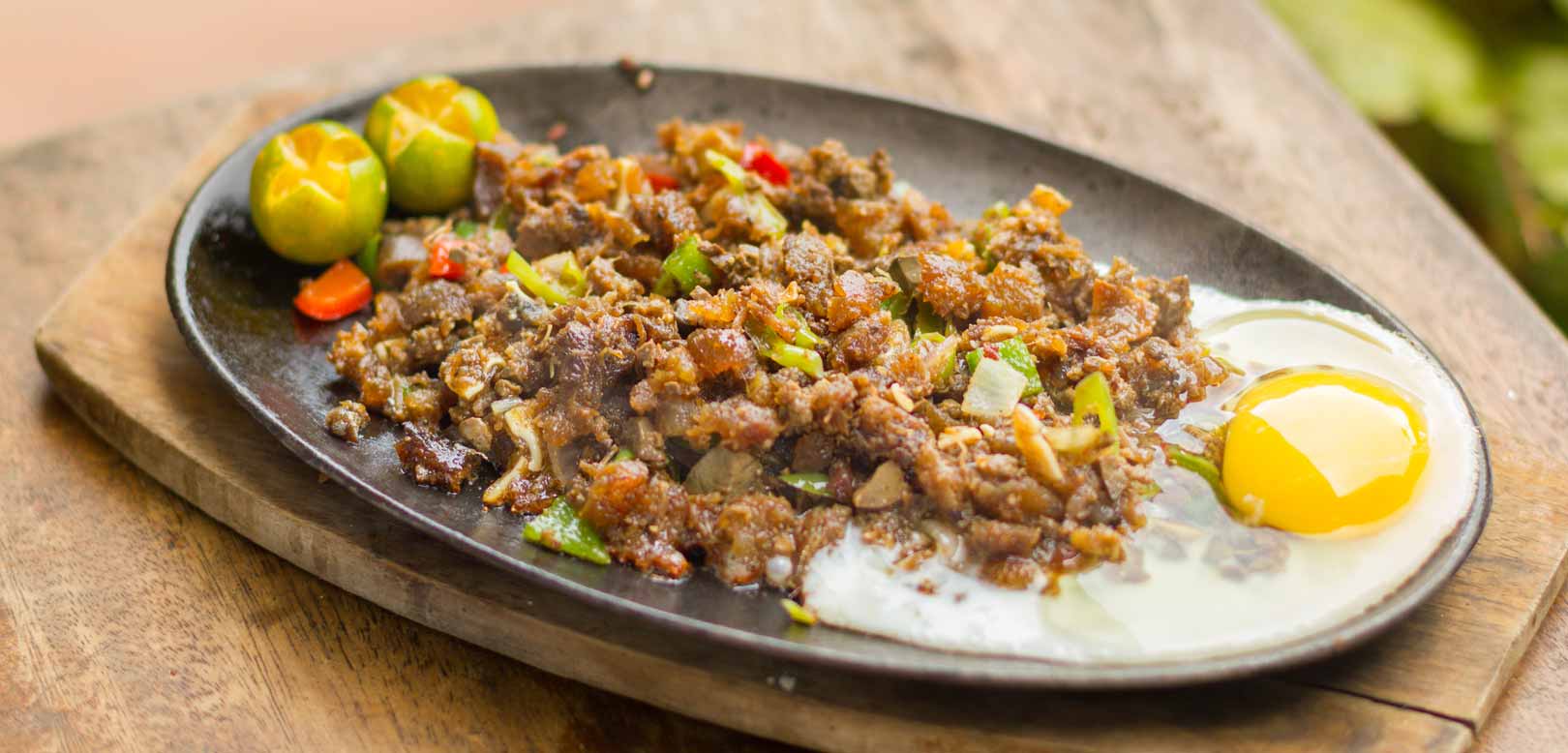
Sisig is another well-known Philippines food that originated in the province of Pampanga, particularly in the city of Angeles. This Kapampangan dish is traditionally made by boiling, chopping, and grilling parts of a pig’s head — yes, you read that right — such as its ears, cheeks, and jowls, which are then seasoned with calamansi, onions, chili peppers, salt, pepper, and vinegar.
Now I know, it sounds pretty morbid especially if you’re not keen on exotic food; but trust me when I say that it is delicious. Pair it with a bottle of local beer like San Miguel and you’re in for a treat! After all, sisig is also commonly known as a pulutan or food that’s best paired with alcoholic drinks. (TRIVIA: The city of Angeles has even declared sizzling sisig babi or pork sisig as an intangible heritage of the city!)
Either way, there are other sisig variants that you can try if you can’t stomach the idea of eating the meat off of a pig’s head such as tuna or chicken sisig.
Where to best eat it? To taste the original and authentic recipe, head to where the Sisig originated: Aling Lucing’s Sisig in Angeles City, Pampanga. The place is also a must to visit when visitors want to try and taste other rich Kapampangan cuisine. Otherwise, if you’re in the capital city of Manila, you can try Manam’s House or Gerry’s Grill.
.
#4 – Sinigang
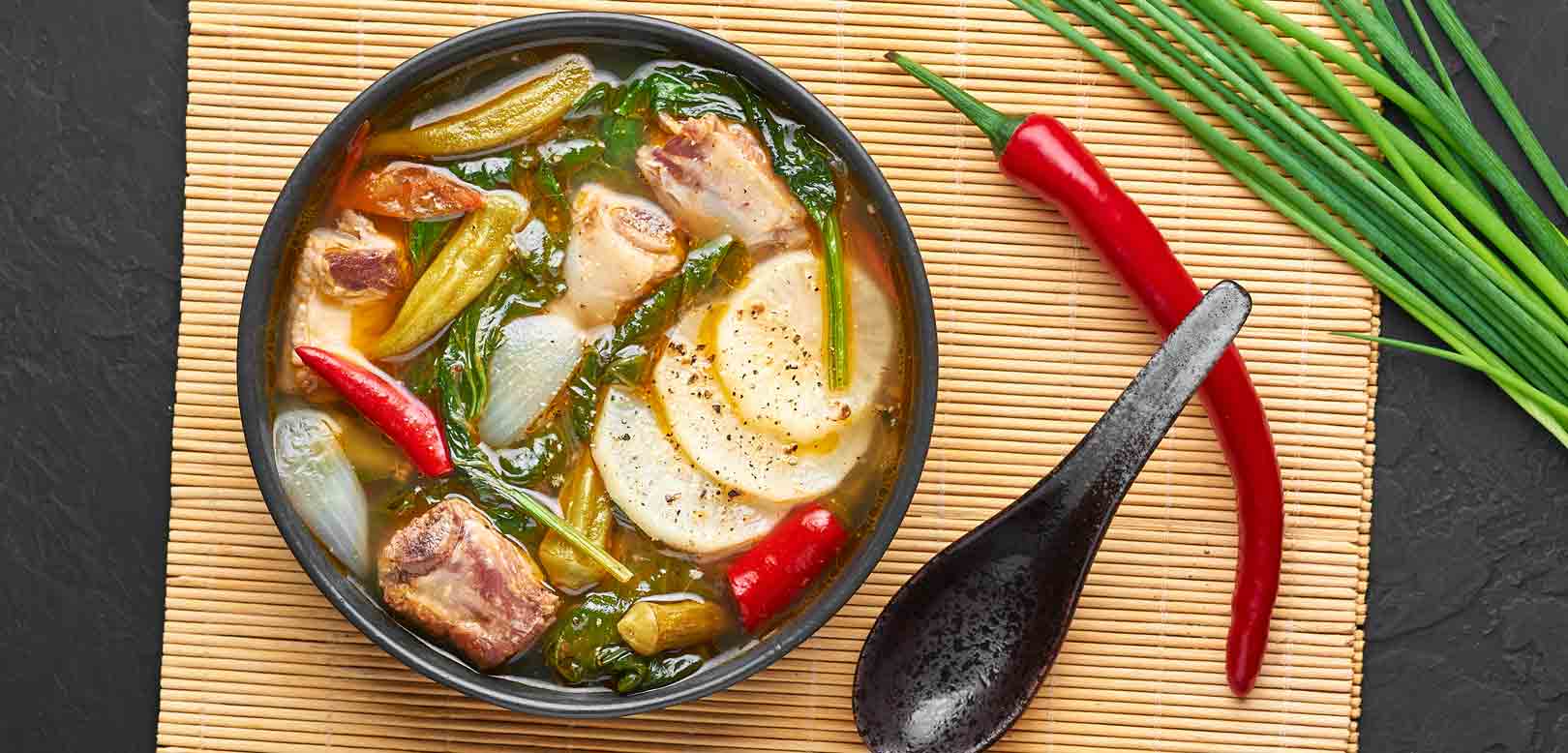
If you’re looking for something to warm you up during rainy season, one of the best Philippines food to try is sinigang! It’s a Filipino stew composed of meat or seafood, and uses tamarind (sampalok) as the souring and savory agent to make its acidic broth (kind of similar to another dish called as paksiw, but this uses vinegar).
A traditional Filipino sinigang is also actually served as a soup, with lots of vegetables like water spinach (kangkong), ladies’ fingers (okra), radish (labanos), taro corns (gabi), eggplant (talong), and string beans (sitaw). To add more to its sourness, ingredients like citruses, gooseberry tree fruits (karmay) and others are also added.
The most common variants of sinigang are pork and fish (like bangus or milkfish), but other favorites are also beef, chicken, and shrimp.
Where to best eat it? Various Filipino restaurants and eateries serve Sinigang on their menu such as places like Victorino’s, Abè, Sentro 1771 or Mamou.
.
#5 – Kare-kare

This is yet another stew dish in the Filipino cuisine but what’s unique about kare-kare as a Philippines food is how it has a thick savory peanut sauce — so those who love anything in peanut flavor will love this!
Usually for this, it consists of meat such as tripe, pork leg, ox tail, beef or goat (sometimes seafood like prawns or mussels) and then mixed with vegetables (at times with veggies only which is called as guleng kare-kare) in a flavorful peanut sauce made of ground roasted peanuts or peanut butter with garlic, onions and annatto seeds. Shrimp paste (bagoong) is often served on the side in order to enhance the taste of the dish.
Where to best eat it? Like other local dishes such as sinigang and adobo, you can try kare-kare at any Filipino restaurant or eatery all over the country. These restaurants have their own versions of Kare-Kare so you can check them out base on your preference.
.
#6 – ‘Silog’ Dishes
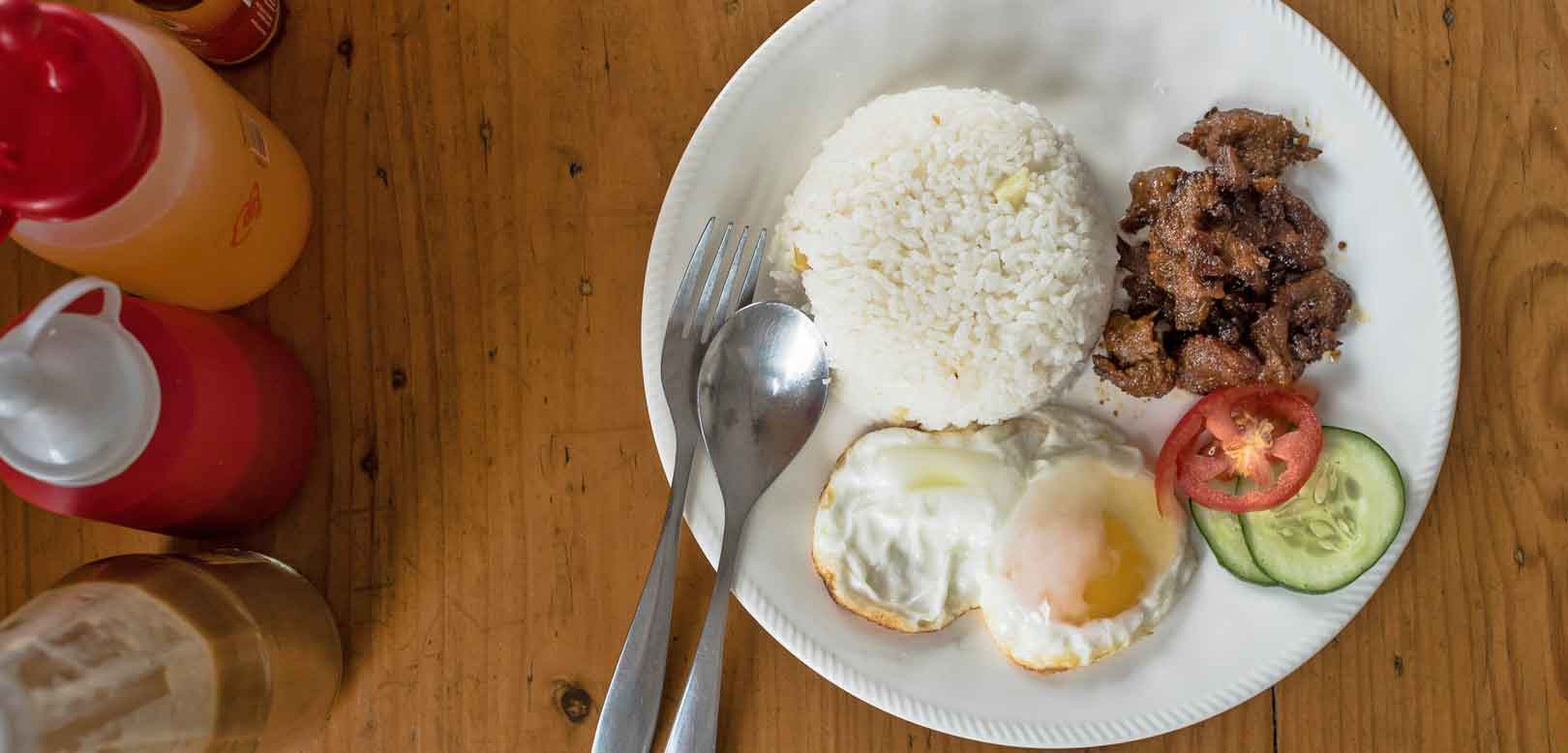
Silog, which stands for sinangag (fried rice) and itlog (egg) is a popular breakfast staple in Filipino cuisine. It is usually served with various viands or ulam like tapa, longganisa or ham — and the most famous variant of it is the tapsilog (tapa, sinangag at itlog). After all, it was the first ‘silog’ that was invented back in the 1980s at Tapsi ni Vivian in Marikina City.
The beef in a well-made tapsilog meal is seasoned with soy sauce, calamansi, brown sugar, black pepper, and minced garlic. Whereas the fried rice has lots of garlic, giving it a strong aroma and taste. Moreover, a traditional tapsilog meal is served with vinegar or atchara (pickled papaya).
For other kinds of ‘silog’, you will usually know what it will contain given the first part of the name: longganisa in longsilog, hotdog in hotsilog, bacon in bacsilog and many more.
Where to best eat it? Several food chains, hotels, and local restaurants incorporated Silog meals on their menu but still, the best place to eat this dish is at a specialized ‘tapsihan’. Numerous tapsihans can be seen at Bambang Street in Manila.
.
#7 – Bulalo
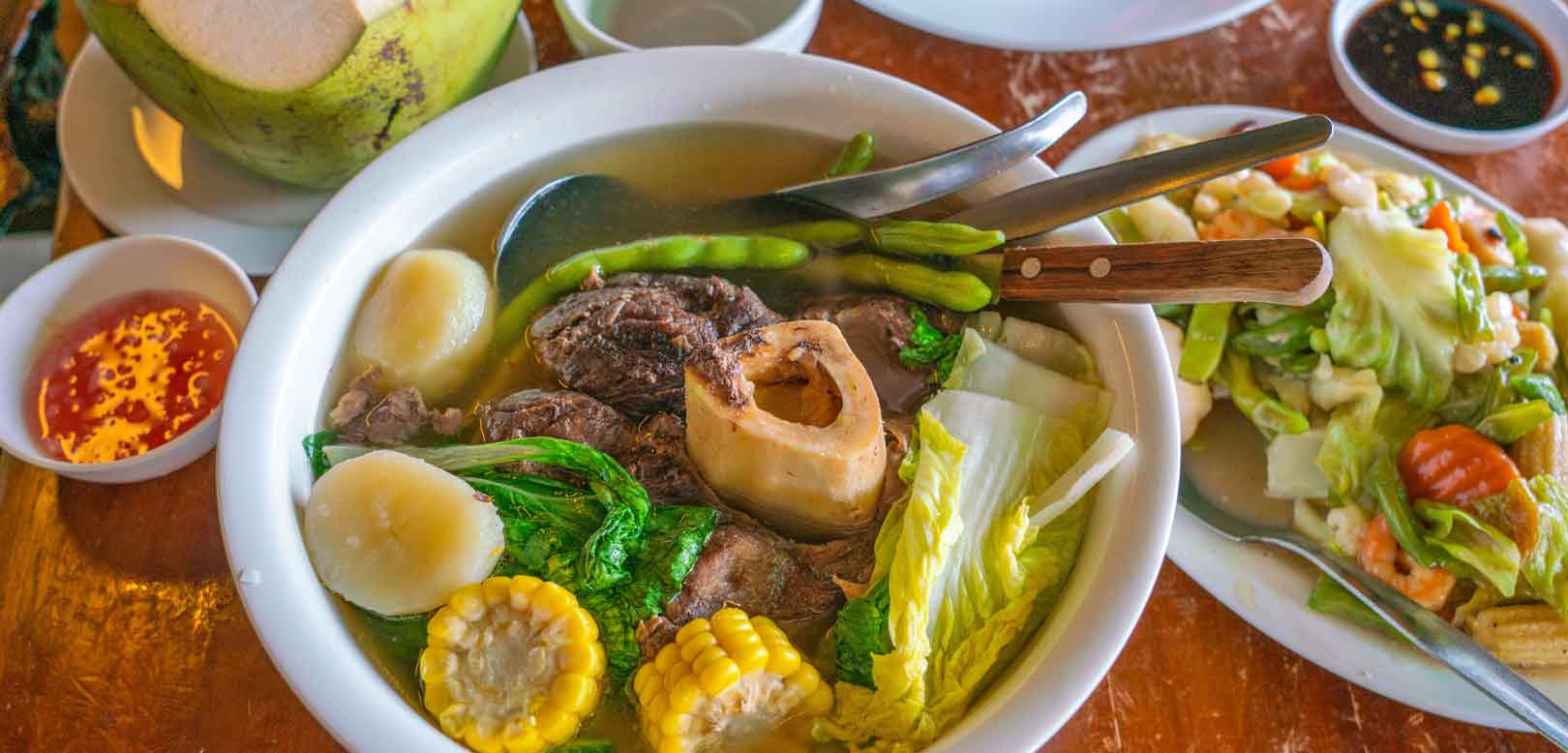
A specialty of Southern Luzon’s Batangas and Cavite, bulalo is personally one of my favorite Filipino beef stew dishes! It’s a treat to eat especially during monsoon season, cold rainy days, or a trip to Tagaytay.
This traditional light-colored soup is prepared by cooking beef shanks and bone marrow until the collagen and fat dissolves into the broth. It is also mixed with different vegetables such as cabbage, pechay, potatoes, taro, string beans and corn among many others. For a complete meal, eat it on rice with soy sauce and calamansi (some would even like patis or fish sauce).
Where to best eat it? Bulalo can be found in any menu of a Filipino-themed restaurant but the best place to try this soup is at the Bulalohan stalls at Mahogany Market in Tagaytay City. You can enjoy your bowl of bulalo while relishing the cold weather of the city. Aside from Tagaytay City, you can also try authentic Bulalo at some towns of Batangas province, where several restaurants specializ in this dish.
.
#8 – Kinilaw
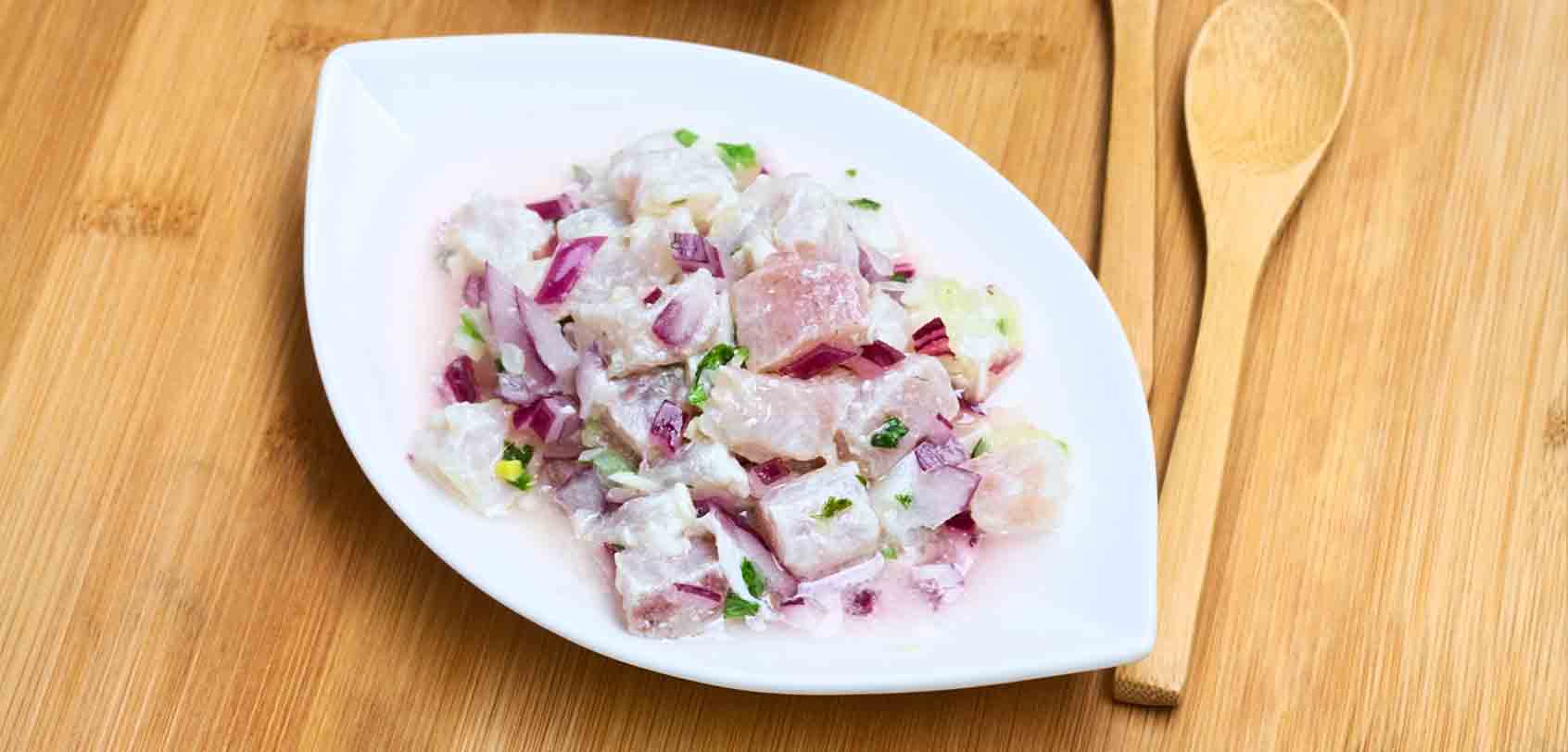
Kinilaw is a Filipino appetizer made with raw, cubed fish in a dressing based on vinegar mixed with garlic, ginger, onion, pepper, and chili. It is similar to Latin America’s appetizer called ceviche or seviche — but the difference is that if ceviche is normally soaked in citrus juices, kinilaw is rather soaked in vinegar. Both of these processes will ‘cook’ the seafood since the acid will change its protein structure.
To add to the difference, Filipinos commonly eat kinilaw as a side dish during beer-drinking sessions instead of an appetizer.
You might have also heard of kilawin and it is actually used interchangeably with kinilaw — but to be more precise, the former is used to refer to a kinilaw-style dish in which the ‘meat’ has already been cooked by heat, whereas the latter is the kind of dish that makes use of raw meat or ingredients like fish.
TIP: Check out my kinilaw recipe!
Where to best eat it? Locals and restaurants from coastal provinces in the Philippines such as Cebu, Palawan, Bohol, etc. serves this dish usually because they can easily get fish (main ingredient) from the nearby seas.
.
#9 – Balut
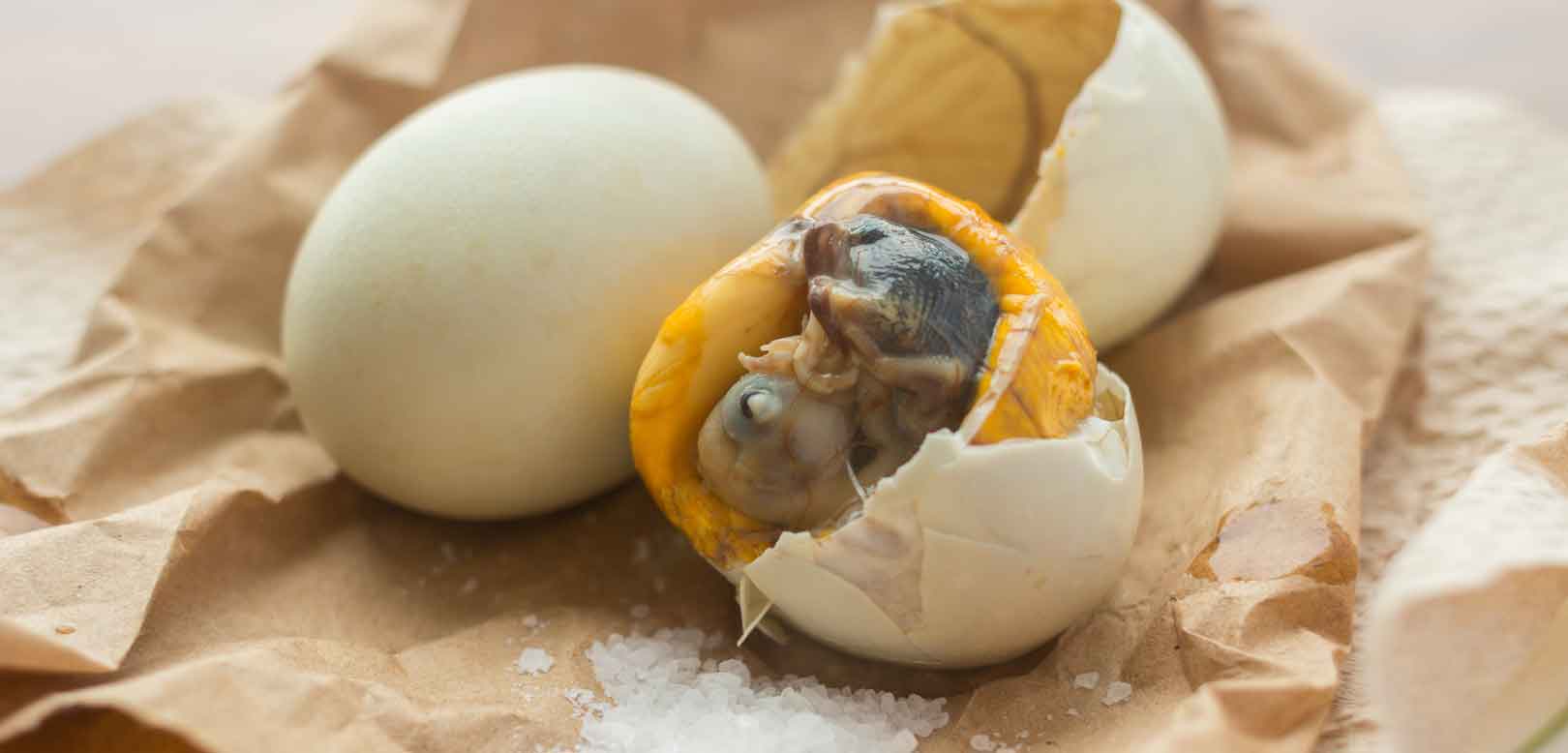
Balut is both a surprise and a challenge for foreigners visiting the country — truth be told, it has become a typical dare that locals would make towards visiting travelers. But honestly, not every Filipino eats this Philippine food or exotic food on a regular basis, yet it still remains to be a must-try (if not some sort of ‘rite of passage’ to the Filipino scene)!
To explain the graphic photo above, balut is a fertilized developing egg embryo that is boiled and eaten as a snack in the shell (NOTE: 14 to 21 days of incubation before it is cooked). It is also often served with a small amount of vinegar. This is definitely the strangest and most famous street food to try in the Philippines that is often sold by vendors during the night, and if you ask me… though I haven’t had the courage to eat everything, I did take a sip of the soup or juice in a balut egg and it was tasty! The rest, I will leave it up to you to tell me haha.
For other street food to try, ask around for isaw (grilled pig/chicken intestines), kwek-kwek (fried quail eggs in batter), helmet (chicken head), adidas (chicken feet), fish balls, or kikiam (meat rolls).
Where to best eat it? Go to Pateros, the “Balut Capital of the Philippines” and taste fresh and authentic balut eggs. But, you can buy Balut anywhere in the Philippines, given that it is a common street food.
.
#10 – Halo-Halo

Halo-halo (translated to ‘mix-mix’) is the most famous of all Filipino desserts and coolers. It is served with mixed fruits and beans, topped with finely crushed ice along with either evaporated milk or ice cream.
The most common halo-halo ingredients include sweetened saba banana, kaong (sugar palm fruit), jackfruit, red mung beans, boiled sweet potatoes, gulaman (agar gelatin), pinipig rice, sugar palm fruit, tapioca pearls, sweet corn, corn crisps, purple yam jam (ube) and leche flan among many others. Most of these solid ingredients are placed at the bottom followed by the shaved ice.
For other Philippines food desserts or merienda items that you must try are: suman (glutinous rice cake), bibingka (baked rice cake), biko (sweet rice cake), buko (coconut) pie, puto bumbong (purple rice cake), turon (sweet fried spring roll), taho (sweet tofu), ube halaya (sweet mashed purple yam), and leche flan (caramel pudding).
Where to best eat it? Halo-halo is usually served in the Philippines during summer season in beach resorts and restaurants. There are plenty of famous and must-try halo-halo variants in the country and this includes Razon’s of Guagua, Halo-Halo de Iloko and Kabigting’s Halo-Halo.
.
BONUS – Drinks to Try
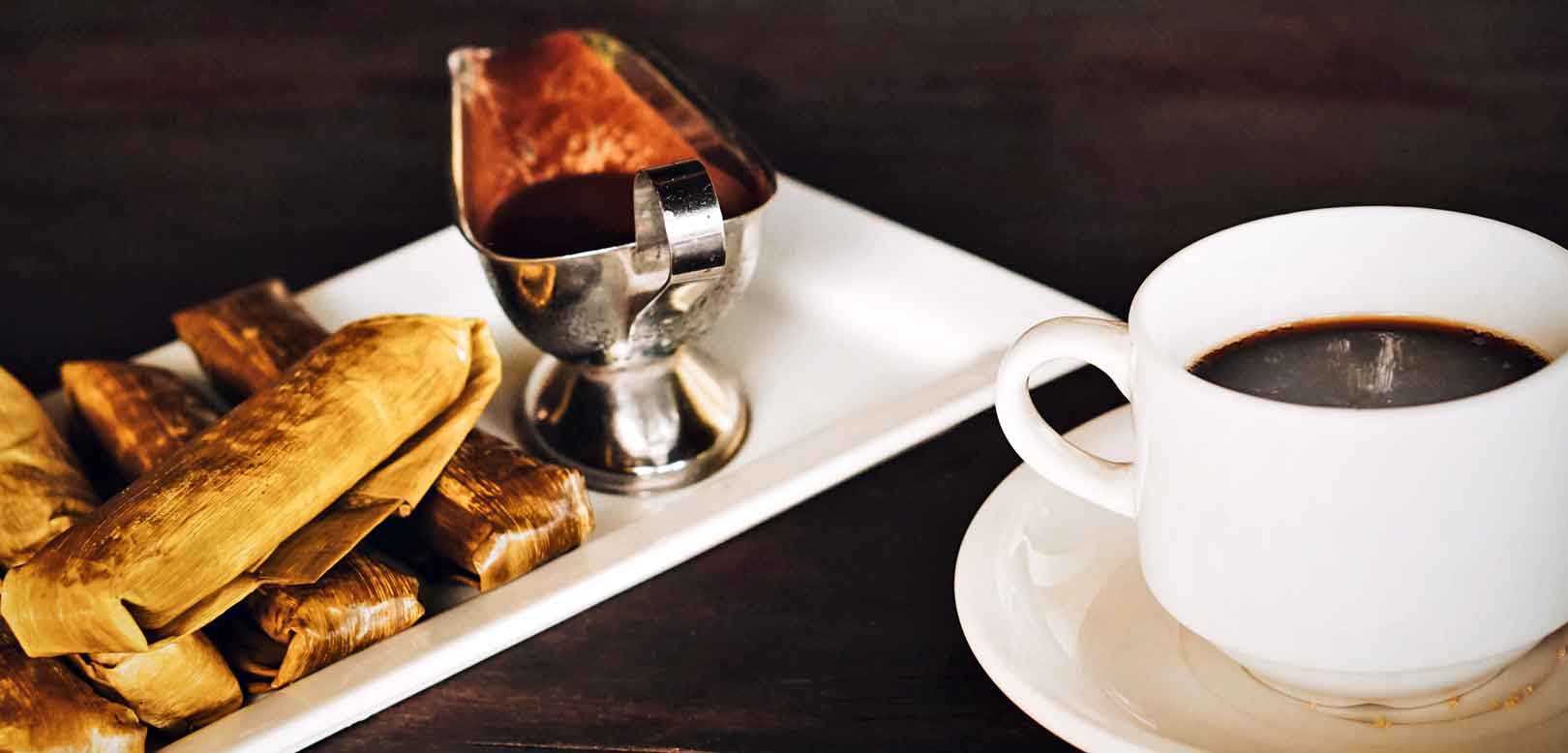
Aside from delicious Philippines food dishes, here are the 2 famous drinks to try when you visit the country:
- KAPENG BARAKO: A variety of coffee that is grown in the province of Batangas. This Filipino version of coffee is known for its pungent aroma and strong taste. With just a sip, it is enough to wake you up from the reverie.
- Where to best try it? Several coffee shops serve Kapeng Barako, but if you’re looking for a more authentic coffee taste, head to Batangas province and choose from several chains of coffee shops that serve it, or you can even buy packs of it to make as your own or to give as gifts (pasalubong).
.
- Where to best try it? Several coffee shops serve Kapeng Barako, but if you’re looking for a more authentic coffee taste, head to Batangas province and choose from several chains of coffee shops that serve it, or you can even buy packs of it to make as your own or to give as gifts (pasalubong).
- LAMBANOG: This potent Filipino drink is made from the fermented sap of the coconut palm. It is a clear, colorless spirit that is quite strong, with the usual alcohol content of 40%. It is usually produced and consumed in provinces of Southern Luzon, particularly Quezon province, which is the largest producer of Lambanog in the Philippines.
- Where to best try it? This famous Filipino spirit is best to purchase at expert Lambanog makers in the province of Quezon, particularly in the town of Tayabas.
.
.
 Oslob Whale Shark Watching
Oslob Whale Shark Watching
Tick off a bucketlist experience!
 Puerto Princesa Underground River
Puerto Princesa Underground River
Day tour to a UNESCO World Heritage Site!
 Bohol Countryside Tour
Bohol Countryside Tour
See Bohol’s top highlights!
.
Let this be the start of your grand gastronomical adventure into the vibrant Filipino cuisine. Enjoy and fill yourself up with these delectable choices starting now!
How about you?
- What do you think of these Philippines food?
- Which dish would you like to try the most?
- Or have you ate any of these before? How was it?
Did you like this article? Follow me on Facebook, Twitter, Instagram, or YouTube and be notified of my newest updates!
The post Philippines Food: Top 10 Must-Eat Local Filipino Dishes appeared first on I am Aileen.
from I am Aileen https://ift.tt/3gyT2xx










No comments:
Post a Comment